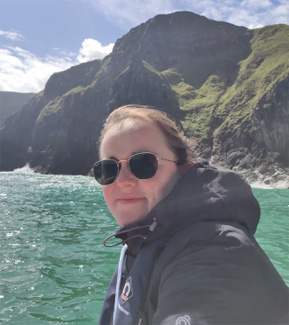Geology Department Postgraduate Web Pages
Name: Lucy Blennerhassett

Contact Details
Phone: 0862425930
Email: blennel@tcd.ie
Title of Project
The effect of climatic warming on the frequency of volcanic eruptions in Iceland
Postgraduate research summary
Climatic warming impacts our environment in many different ways. Over the last decade or so it has been observed that one of those impacts may include increased volcanic eruption frequency in locations where volcanic centres are covered by ice. Largely, this has been attributed to increases in mantle decompression melting in response to ice load removal on the land surface. Iceland is a perfect location to study this relationship as it was extensively covered by ice during the last glacial period until the beginning of the Holocene at approximately 11,700 years BP. It’s volcanism has also been heavily influenced by decompression melting. Traditionally, the relationship between climate and volcanism during the Quaternary period has relied on volcanic aerosol traces and ash layers within ice cores from Greenland and Antarctica. In recent years, tephrochronology within Holocene peat and sedimentary archives has been used as a tool to reconstruct eruption frequencies in Iceland during periods of climatic change. Distal, invisible ash layers known as ‘cryptotephra’ found in locations such as Ireland, The Faroe Islands and other parts of Western Europe indicate potentially powerful past eruptions, creating far travelling ash clouds. However, gaps exist within the distal tephra record and the dominant form of preserved tephra is rhyolitic. There is a clear disparity here as basaltic geochemistry accounts for most of Iceland’s volcanism. Although rhyolitic systems are most commonly associated with explosive volcanic activity, basaltic eruptions may also cause ash generation when interacting with water (phreatomagmatic activity) eg. The Laki eruption in 1783.
The overall aim of this project is to detect volcanic aerosols and altered tephra horizons from ombrotrophic (raised) peat bogs in Ireland to help account for gaps in the distal Icelandic record. A novel method known as ETV-ICP-OES has been developed for this purpose. Tephra findings along with geochemical signatures collected via ETV-ICP-OES will be combined with oxygen isotope data from Greenland ice, to build a more refined picture of Icelandic eruption frequency since the end of the last glacial period. Successful detection of volcanic heavy metal and sulphur aerosols in peat is also a valuable way to enhance our understanding of aerosol distribution away from the poles. Additionally, an understanding of how our planet has reacted to global ice loss in the past is key to understanding how it may react in the future. This is societally significant, especially if it means a potentially higher frequency of explosive volcanic eruptions as our planet continues to warm.
Name of supervisors
Dr. Emma Tomlinson
Postgraduate personal details
Lucy graduated from Trinity College Dublin in 2017 with a Bachelors Degree (1st Class Hons) in Earth Science. As well as having a keen interest in understanding the earth system, she is passionate about science communication, especially within the context of climate change and public understanding. She has been involved with communication programmes such as The Cool Planet Experience, Girls into Geoscience (2019, 2021), Scholars Ireland with TCD AccessEd (2020/2021), iCRAG at The Rediscovery Centre (Science Week, 2019) and I’m A Scientist Stay at Home (2020).
Project Start Date
September 1st 2018
Funding
iCRAG/SFI-GSI: Environmental Geoscience Programme
Other relevant information
Twitter: @CoolPlanet_Lucy

